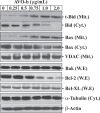In vitro cytotoxicity of Artemisia vulgaris L. essential oil is mediated by a mitochondria-dependent apoptosis in HL-60 leukemic cell line
- PMID: 25002129
- PMCID: PMC4227289
- DOI: 10.1186/1472-6882-14-226
In vitro cytotoxicity of Artemisia vulgaris L. essential oil is mediated by a mitochondria-dependent apoptosis in HL-60 leukemic cell line
Abstract
Background: The essential oil (EO) of Artemisia vulgaris L. has been traditionally used worldwide for treating a large number of diseases. Although major components in A. vulgaris EO have been shown to inhibit growth of different cancer cells, as pure compounds or part of other plants extracted oil, no information is known about its anti-proliferative activities. Therefore, the current investigation has evaluated the toxicity of the plant extracted oil from buds (AVO-b) and leaves (AVO-l) and characterized their growth inhibitory effects on cancer cells.
Methods: AVO-b and AVO-l from A. vulgaris L. were extracted by hydrodistillation, and their effect on the viability of human HL-60 promyelocytic leukemia and various other cancer cell lines was tested using MTT assay. Flow cytometric analysis of apoptosis, DNA fragmentation assay, caspases enzymatic activities and Western blotting were used to determine the apoptotic pathway triggered by their action on HL-60 cells.
Results: Low concentrations of AVO-b and AVO-l inhibited the growth of HL-60 cells in a dose- and time-dependent manner. Employing flow cytometric, DNA fragmentation and caspase activation analyses, demonstrated that the cytotoxic effect of the oils is mediated by a caspase-dependent apoptosis. Kinetic studies in the presence and absence specific caspase inhibitors showed that activation of caspase-8 was dependent and subsequent to the activation of caspases-9 and -3. In addition, the essential oil caused a disruption of the mitochondrial transmembrane potential (ΔΨm), increased the release of cytochrome c to the cytosol, and altered the expression of certain members of Bcl-2 family (Bcl-2, Bax and Bid), Apaf-1 and XIAP. Interestingly, low doses of AVO-b and AVO-1 also induced apoptosis in various cancer cell lines, but not in noncancerous cells.
Conclusions: The results demonstrate that the EO-induced apoptosis in HL-60 cells is mediated by caspase-dependent pathways, involving caspases-3, -9, and -8, which are initiated by Bcl-2/Bax/Bid-dependent loss of ΔΨm leading to release of cytochrome c to the cytoplasm to activate the caspase cascade. The finding that AVO-b and AVO-l are more efficient to induce apoptosis in different cancer cell lines than noncancerous cells, suggests that A. vulgaris might be a promising source for new anticancer agents.
Figures







Similar articles
-
Essential oil of Artemisia capillaris induces apoptosis in KB cells via mitochondrial stress and caspase activation mediated by MAPK-stimulated signaling pathway.J Food Sci. 2009 Nov-Dec;74(9):T75-81. doi: 10.1111/j.1750-3841.2009.01355.x. J Food Sci. 2009. PMID: 20492133
-
The pyridone-annelated isoindigo (5'-Cl) induces apoptosis, dysregulation of mitochondria and formation of ROS in leukemic HL-60 cells.Cell Physiol Biochem. 2015;35(5):1958-74. doi: 10.1159/000374004. Epub 2015 Mar 27. Cell Physiol Biochem. 2015. PMID: 25871324
-
Capillin, a major constituent of Artemisia capillaris Thunb. flower essential oil, induces apoptosis through the mitochondrial pathway in human leukemia HL-60 cells.Phytomedicine. 2015 May 15;22(5):545-52. doi: 10.1016/j.phymed.2015.03.008. Epub 2015 Mar 27. Phytomedicine. 2015. PMID: 25981920
-
Apoptogenic activity of 2α,3α-dihydroxyurs-12-ene-28-oic acid from Prunella vulgaris var. lilacina is mediated via mitochondria-dependent activation of caspase cascade regulated by Bcl-2 in human acute leukemia Jurkat T cells.J Ethnopharmacol. 2011 Jun 1;135(3):626-35. doi: 10.1016/j.jep.2011.03.067. Epub 2011 Apr 5. J Ethnopharmacol. 2011. PMID: 21473903
-
Staying alive: bacterial inhibition of apoptosis during infection.Trends Microbiol. 2008 Apr;16(4):173-80. doi: 10.1016/j.tim.2008.02.001. Epub 2008 Mar 18. Trends Microbiol. 2008. PMID: 18353648 Free PMC article. Review.
Cited by
-
Artemisia Capillaris leaves inhibit cell proliferation and induce apoptosis in hepatocellular carcinoma.BMC Complement Altern Med. 2018 May 8;18(1):147. doi: 10.1186/s12906-018-2217-6. BMC Complement Altern Med. 2018. PMID: 29739391 Free PMC article.
-
Cytotoxic Activity and Phytochemical Analysis of Artemisia haussknechtii Boiss.Iran J Pharm Res. 2022 Apr 30;21(1):e126917. doi: 10.5812/ijpr-126917. eCollection 2022 Dec. Iran J Pharm Res. 2022. PMID: 36060921 Free PMC article.
-
Artemisia vulgaris inhibits BCR/ABL and promotes apoptosis in chronic myeloid leukemia cells.Biomed Rep. 2022 Oct 5;17(6):92. doi: 10.3892/br.2022.1575. eCollection 2022 Dec. Biomed Rep. 2022. PMID: 36382259 Free PMC article.
-
A study on screening and antitumor effect of CD55-specific ligand peptide in cervical cancer cells.Drug Des Devel Ther. 2018 Nov 13;12:3899-3912. doi: 10.2147/DDDT.S182337. eCollection 2018. Drug Des Devel Ther. 2018. PMID: 30519000 Free PMC article.
-
Significance of Artemisia Vulgaris L. (Common Mugwort) in the History of Medicine and Its Possible Contemporary Applications Substantiated by Phytochemical and Pharmacological Studies.Molecules. 2020 Sep 25;25(19):4415. doi: 10.3390/molecules25194415. Molecules. 2020. PMID: 32992959 Free PMC article. Review.
References
-
- Jemal A, Bray F, Center MM, Ferlay J, Ward E, Forman D. Global cancer statistics. CA Cancer J Clin. 2011;61(2):69–90. - PubMed
-
- Klein G. Cancer, apoptosis, and nonimmune surveillance. Cell Death Differ. 2004;11(1):13–17. - PubMed
-
- Hu W, Kavanagh JJ. Anticancer therapy targeting the apoptotic pathway. Lancet Oncol. 2003;4(12):721–729. - PubMed
-
- Kaufmann SH, Earnshaw WC. Induction of apoptosis by cancer chemotherapy. Exp Cell Res. 2000;256(1):42–49. - PubMed
-
- Alnemri ES. Mammalian cell death proteases: a family of highly conserved aspartate specific cysteine proteases. J Cell Biochem. 1997;64(1):33–42. - PubMed
Publication types
MeSH terms
Substances
LinkOut - more resources
Full Text Sources
Other Literature Sources
Research Materials

